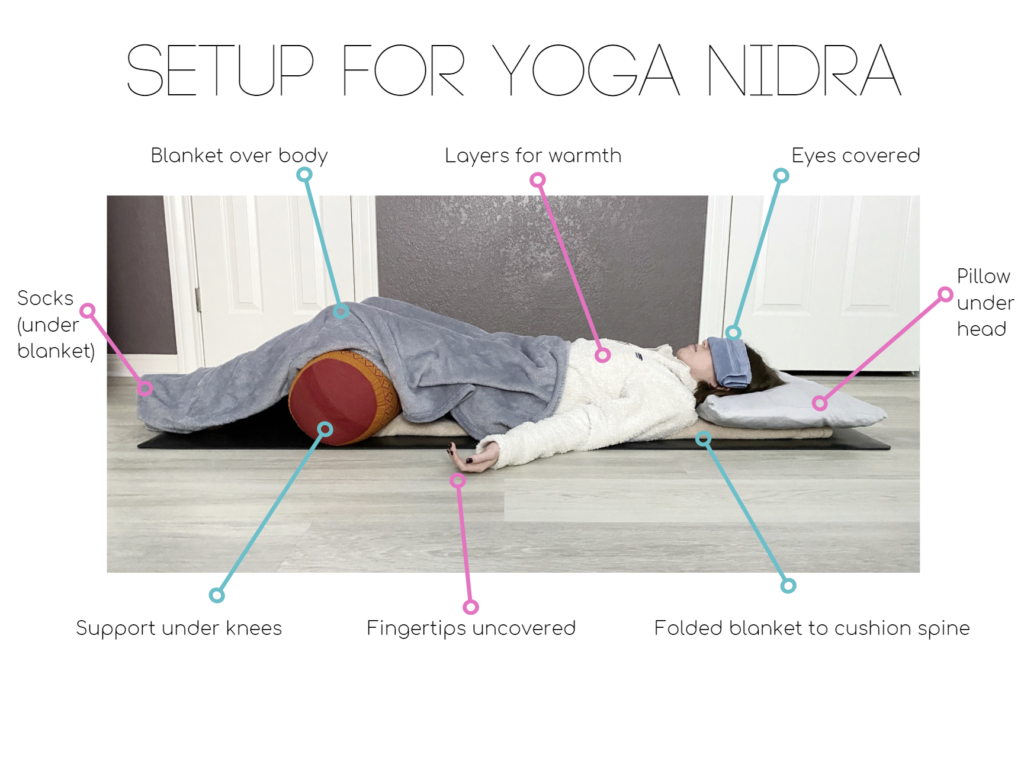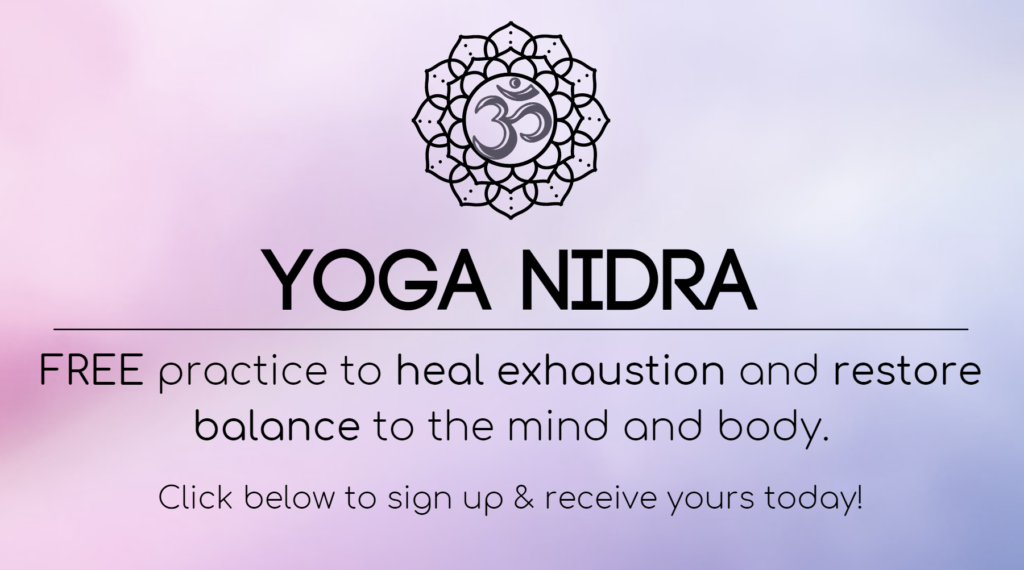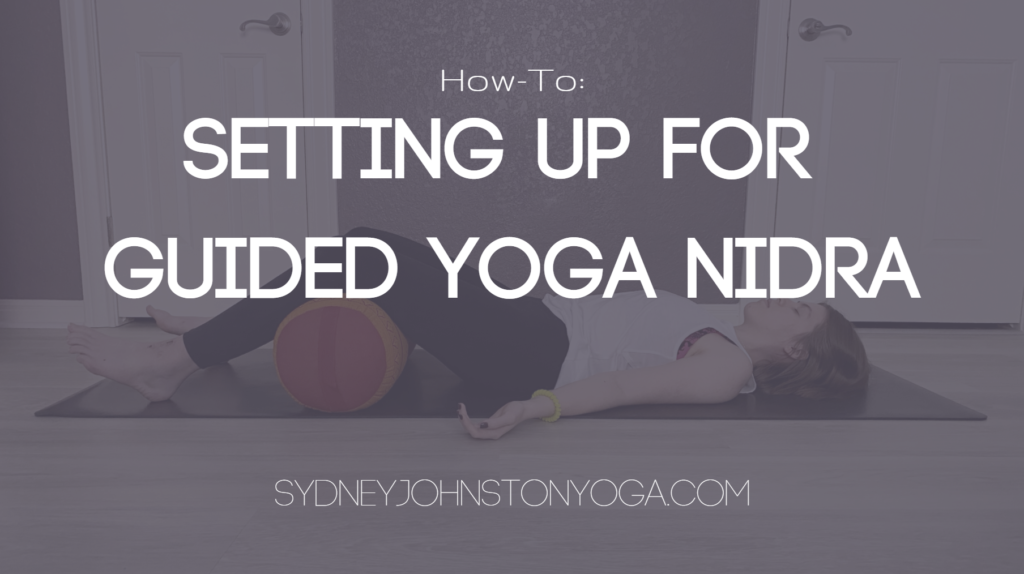Yoga nidra, also known as “yogic sleep,” is a practice of moving through the layers of the self, with the purpose of disassociating oneself from the physical body to become aware of the divine self that exists beyond, and is unattached to, the body.
If this all sounds a bit esoteric, don’t worry. I have more articles to come that will delve into what exactly yoga nidra is (from a yogic philosophy standpoint), the history of it, and the purposes of practicing yoga nidra.
For now, what you need to know is that yoga nidra is much less daunting to practice than to discuss – when guided through a yoga nidra, you will lie down and get comfortable, become aware of tension in your body and release it, allow the breath to move naturally (instead of forcing deep breaths), and then rotate the awareness through different body parts as instructed by your teacher. Students often find that yoga nidra provides many of the same benefits as meditation: relaxation, increased energy and focus, reduced anxiety and stress, better concentration, and improved sleep.
Traditional guided yoga nidras are a minimum of 20-30 minutes, and can often span an hour (or more!). Setting up properly is critical to remain comfortable throughout the duration of your yoga nidra, since it is best to remain still for the entire practice.
Even if you’ve never done yoga nidra before, by the time you have finished this post you will be ready to successfully set yourself up for a comfortable yoga nidra practice!
Bonus: be sure to check out the end of this article for a special offer to begin your journey into yoga nidra!

Setup for Yoga Nidra
Choose a Location
- It is best to avoid doing yoga nidra in bed because we want the body and mind to grow tranquil while retaining a trace of awareness (the mind remains conscious). The mind is conditioned to go entirely to sleep (thus losing all consciousness) when we lie down in bed, and we want to refrain from falling asleep during yoga nidra.
- Instead, practice on a floor (wood or carpet). I highly recommend unrolling a yoga mat or using a rug for extra cushioning.
Set the Ambience
- Dim the lights: Yoga nidra is an introspective and healing practice, so much like restorative yoga, it is enhanced by a darker surrounding environment.
- Yoga and pranayama: Yoga and pranayama are highly recommended before doing yoga because they tend to the physical and subtle body energies respectively, helping practitioners to calm and ground for the yoga nidra practice. If you’re short on time or unsure of what pranayama is and how to do it, try a short 5-10 minute yoga routine followed by 2-5 minutes of deep, conscious breathing.
- Set an intention: Many students find it hard to stay awake during yoga nidra, so feel welcome to set an intention to stay aware during your practice.
Dress the Part
- Sweater/fleece for warmth: It is common to grow cold during yoga nidra because the body is entirely still for such a long time, so it is critical to warmly enough to stay comfortable and relaxed (shivering is caused by muscles contracting and tensing up – the opposite of our goal to relax and release tension during yoga nidra!). Although pricey, this is absolutely my favourite fleece for yoga nidra…super warm and the zipper allows me to keep my neck free of stimulation from a collar or fabric!
- Socks: Socks are another important piece of apparel for staying warm (ever notice that you’re cold all over if your feet are cold?), and also add some cushioning between the heels and floor surface.
Props and Setup
- Folded blanket under spine: The spine can be very sensitive, especially if you’re on a wood floor, and often the cushioning of a yoga mat is not enough to keep it comfortable during a longer practice. Fold a blanket into a long rectangle and place it on top of your yoga mat to provide extra cushioning for the spine and sacrum. The blanket should be long enough to protect your head, entire back body, and sacrum and pelvis.
- Support under knees: When the legs are extended straight out, the lower back is forced to arch off the floor. This can cause strain and severe discomfort after a few minutes, especially if you have spine conditions, back pain, or disc injuries. But this pain can be avoided by placing a yoga bolster, pillows, or a folded blanket/towel under the knees in order to bend them and bring the entire back body flat on the floor, which takes all the unnecessary strain out of the low back.
- Pillow under head: After 15-20 minutes of lying on the floor (even carpeted floor!), the back of your head will begin to hurt – trust me, I’ve learned the hard way! This is remedied by placing a pillow under the head, although try to use a flat pillow so that the neck and upper spine are not forced out of their natural curve (which would be caused by a pillow that is too high forcing the head to jut up toward the ceiling).
- Blanket over body: Again, many of us will grow cold due to the still nature of yoga nidra, and shivering is the last thing we want because of the discomfort and tension it creates in the body. Cover yourself in a large blanket, and wrap it around the feet to provide an additional layer of cushioning between the heels and floor). I usually avoid pulling the blanket all the way up to my neck, since the skin there is very sensitive and feels best when not stimulated by fabric or clothes, so experiment and see if you feel best having the blanket up to your waist, chest, or neck.
- Eyes covered: Although not necessary, an eye covering enhances the introspective and healing qualities of yoga nidra by blocking out any stimulating sources of light that may be present. I do not like eye masks for yoga nidra because I personally find them too oppressive and forceful; instead, I opt for either an eye pillow or a light cloth (the traditional and ancient yoga nidra eye covering), such as a washcloth or shirt.
- Fingertips uncovered: Keeping the fingertips free of any stimulating material may be the most important part of setting up for yoga nidra. Having any material in contact with the fingertips was traditionally considered too stimulating to fully relax and detach from the body, so keep your hands out from underneath the blanket, palms turned upward, and only air in contact with the fingertips.
And that’s it! Setting up for yoga nidra is a special and meditative ritual, so treat it as such: take out and put away your props with love, devotion, and care, and respect the ancient practice by honouring the assembly and disassembly of your setup.
And now, for my special offer…
Want to try yoga nidra? Get my FREE guided 20-minute yoga nidra recording!!


